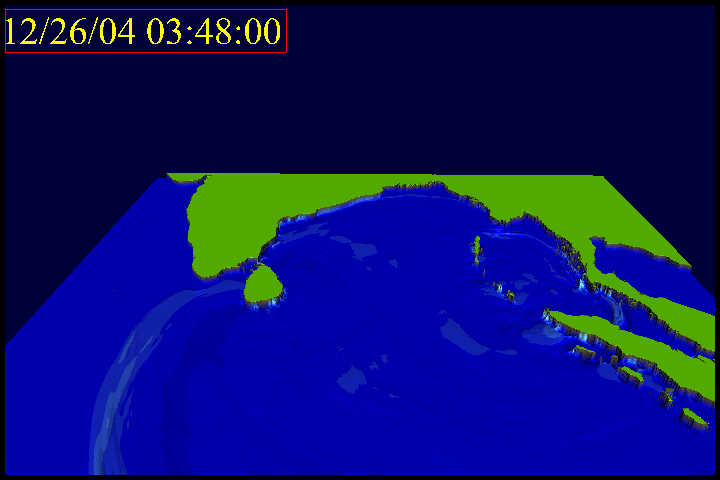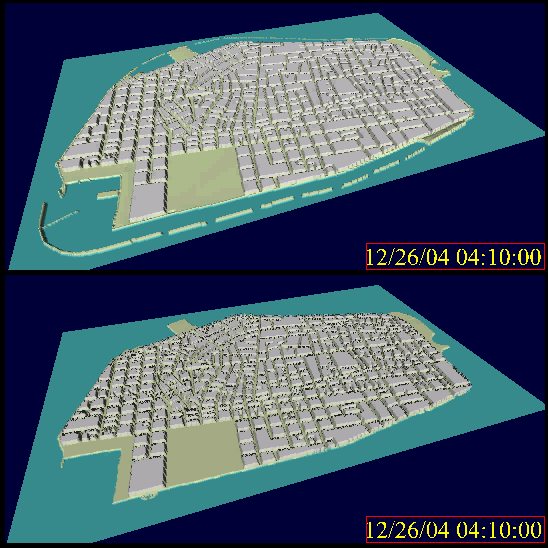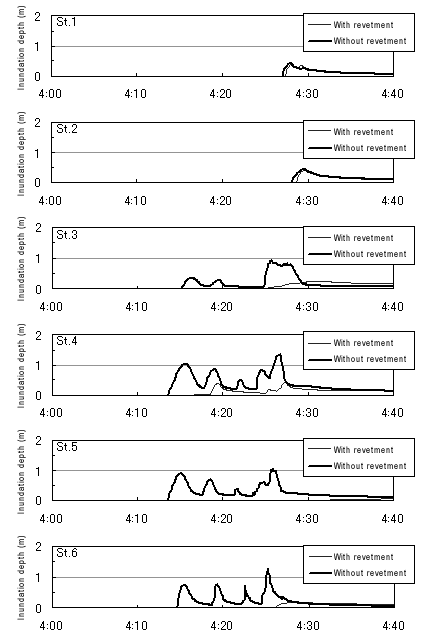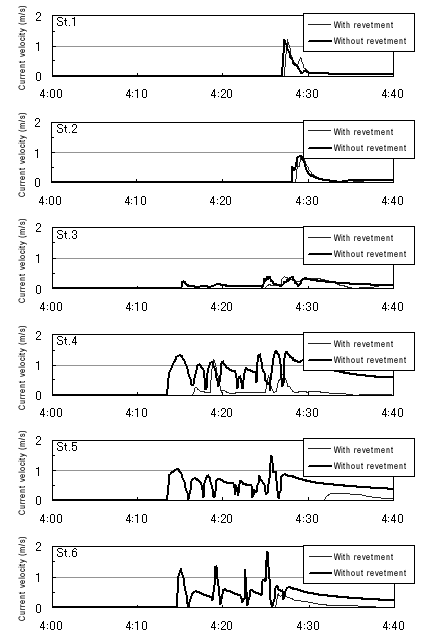5. Effect of coastal revetment on tsunami run-up
The M9.0 earthquake that occurred off Sumatra Island on December 26, 2004 caused a huge tsunami, inflicting enormous damage far along the coasts of the Indian Ocean. This tsunami hit shore not merely on Sumatra Island of the Republic of Indonesia, which was close to the hypocenter, but also Sri Lanka and the Republic of Maldives, which are more than 1,000 km from the hypocenter. With fatalities reaching about 300,000 in total, this disaster was a global-scale tragedy. The damage is considered to have been exacerbated by the lack of tsunami forecast and warning systems and lack of awareness of tsunami.
Along the coasts in Japan, concrete levees and revetments have been constructed for protecting the hinterland from storm surges, tidal waves, and tsunami. There are few such facilities along the coasts of the Indian Ocean except for ports and harbors. However, on Male Island, which is the national capital of the Republic of Maldives, revetments and other structures have been constructed around the island supported by Official Development Assistance of the Japanese Government since the island suffered damage due to storm surges in 1987 and 1988. The island was relatively unaffected by the Sumatra tsunami because these revetments helped protect the island from inundation.
In view of the necessity of quantitatively assessing the effect of levees and other coastal conservation facilities on tsunami run-up, our division conducted calculations by reproducing this tsunami, and assessed the effect of the revetments of Male Island on the tsunami run-up.
The numerical calculation of the tsunami was conducted by using a model in which the effects of bottom friction, turbulent flow, and Coriolis force were incorporated into the non-linear long-wave equation. As the initial condition, the vertical component of seabed deformation obtained by calculations using a fault model was given as the water level variation at the sea surface.
Figure 1 shows how the tsunami propagated from the time the earthquake occurred in the Indian Ocean. When the earthquake struck, wave uprush occurred on the western side of the hypocenter, and wave backrush on the eastern side. Tsunami waves propagated mostly from east to west, and uprush reached the northern end of Sumatra Island following backrush 0.5 hours after the earthquake. Two hours after the earthquake, uprush reached Sri Lanka, and uprush, following backrush, struck near Phuket in Thailand. Three hours and ten minutes after the earthquake, uprush reached Male Island.

Figure 1 Tsunami wave propagation in the Indian Ocean
Figure 2 shows the state of tsunami run-up at Male Island for the cases with (upper) and without (lower) revetment.

Figure 2 State of tsunami wave run-up with and without revetment
Figure 3 shows the difference in the inundation depth at six sites of the island due to the availability of revetment. At St. 1 and 2, which are situated on the north coast, the difference in inundation depth due to the effect of revetment was not conspicuous because the ground elevation is as high as the revetment. At St. 3 to 6, on the other hand, inundation commenced earlier when there is no revetment and the maximum inundation depth more than doubled. At St. 4 to 6, the inundation depth changed corresponding to tide level fluctuation at the east and south coasts.
Figure 4 shows the difference in current velocity in the similar manner as in Figure 3. At St. 1 and 2, the revetments made almost no difference as with the case of inundation depth. At St. 3, which is located on the west coast, the maximum current velocity hardly changed with or without revetment, unlike the case of inundation depth. At St. 4 to 6, the maximum current velocity was 1 m/s or lower when revetment was available, but became greater than 1 m/s when revetment was not available. The current velocity conspicuously increased particularly at St. 5 and 6 which are located on the east coast where the tsunami landed.
The above results revealed the following: When there was no revetment, tsunami waves coming from the east ran up onto the ground from the southeast area. When there was revetment, wave run-up from the southeast area was hindered; inundation started from the southwest area where the height of revetment was relatively low; and the revetment lowered the inundation depth and current velocity on the ground.

Figure 3 Comparison of inundation depth

Figure 4 Comparison of current velocity
The results of calculating tsunami wave run-up showed that revetment with recurved parapet not only lowers the inundation depth but also reduces the flow velocity on the ground. Given that hydrodynamic force is proportional to the square of current velocity in general, the lowered flow velocity due to revetment is considered to have greatly reduced physical damage.
Thus, levees and other coastal conservation facilities help reduce tsunami wave run-up. Coastal conservation facilities are considered to be effective in mitigating damage due to tsunami particularly in places such as Male Island that have a large population on low-lying land.